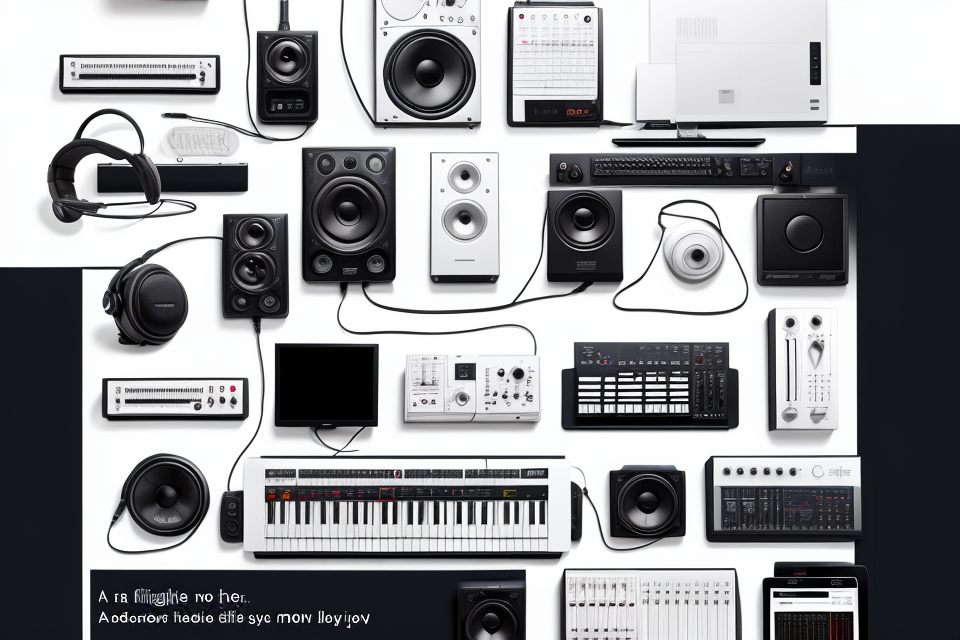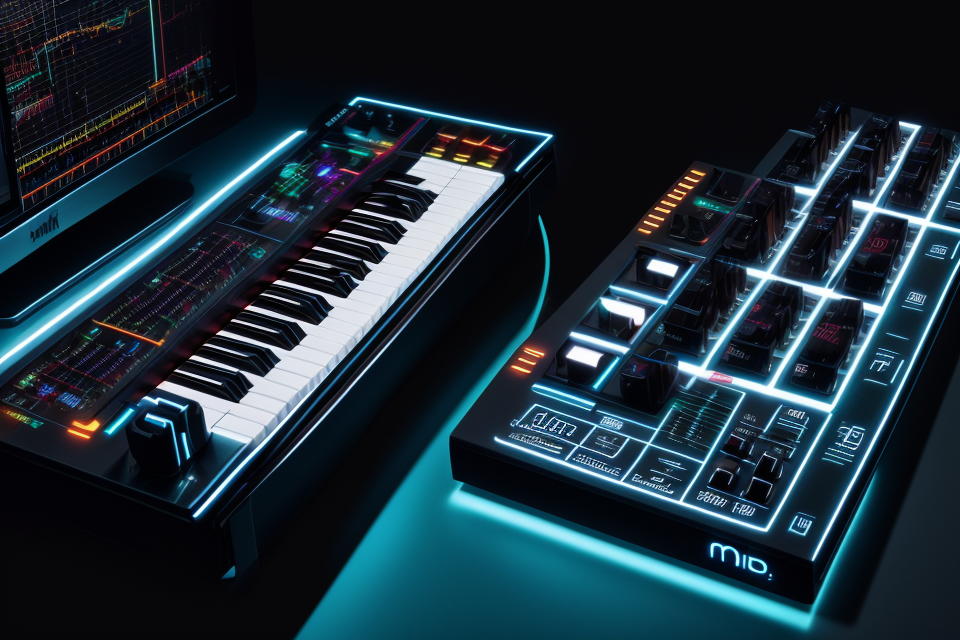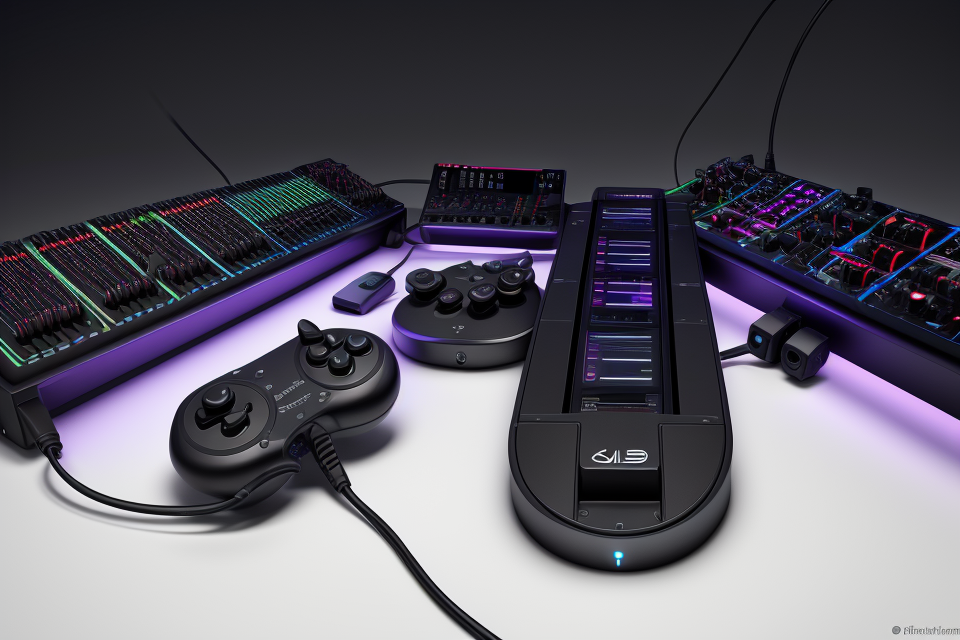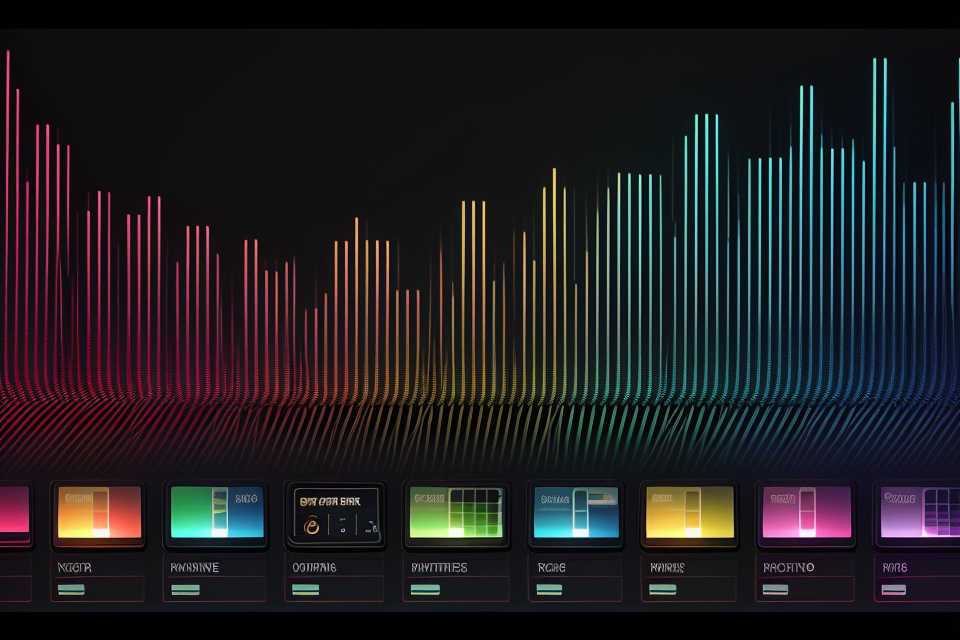
Are you a musician or a producer struggling to decide whether to invest in a keyboard or a MIDI controller? Choosing the right tool can be crucial to your creative process and overall output. In this article, we will explore the key differences between these two instruments and provide you with a comprehensive guide to help you make an informed decision. Whether you’re a beginner or an experienced professional, this article will help you understand the pros and cons of each option and determine which one is the best fit for your needs. So, let’s dive in and discover the world of keyboard and MIDI controllers!
What is a Keyboard?
Types of Keyboards
There are two main types of keyboards: acoustic and digital.
Acoustic Keyboards
Acoustic keyboards are traditional pianos that produce sound through strings and hammers. They are typically more expensive and require more space than digital keyboards, but offer a more authentic playing experience.
Digital Keyboards
Digital keyboards use electronic sound generators to produce sound. They are often more affordable and compact than acoustic keyboards, and can be a good option for beginners or those who need a portable keyboard for gigs or recording sessions. Digital keyboards can also mimic the sound of other instruments, making them versatile for different genres of music.
Advantages and Disadvantages of Keyboards
Advantages
- Natural and expressive playing: Keyboards offer a more traditional playing experience for pianists, providing a familiar and natural way to play and express themselves through music.
- Full-range of notes: Keyboards have a wider range of keys, allowing for greater dynamic expression and more complex compositions.
- Ease of use: Keyboards are typically easier to set up and use, requiring minimal setup and maintenance.
- Portability: Many keyboards are lightweight and portable, making them easy to transport for gigs or performances.
- Affordability: Keyboards can be more affordable than MIDI controllers, making them a more accessible option for beginner or intermediate musicians.
Disadvantages
- Limited customization: Keyboards do not offer the same level of customization as MIDI controllers, limiting the range of sounds and effects that can be produced.
- Less durable: Keyboards are more susceptible to damage from moisture, dust, and other environmental factors, making them less durable than MIDI controllers.
- Noisy: Some keyboards can be loud, especially when playing at high volumes, which can be a problem in recording or performance settings.
- Not as versatile: Keyboards are not as versatile as MIDI controllers, as they are limited to the sounds and functions built into the instrument.
- Not as intuitive: Keyboards may require more practice and adjustment for musicians who are used to playing other instruments or using different equipment.
What is a MIDI Controller?
Definition of MIDI Controller
A MIDI controller is an external device that allows you to connect your musical instruments, computers, or other devices to produce, record, and manipulate music. MIDI stands for “Musical Instrument Digital Interface,” and it was first introduced in the 1980s as a standard protocol for connecting various music devices.
A MIDI controller typically consists of a physical interface that allows you to input notes, adjust settings, and trigger sounds using knobs, buttons, sliders, and other controls. These controllers can range from small, portable devices to large, complex setups with multiple layers and functions.
MIDI controllers are commonly used in recording studios, live performances, and music production. They provide a flexible and customizable way to interact with various software and hardware tools, enabling musicians and producers to create and manipulate sound in new and innovative ways.
In addition to controlling software synthesizers and virtual instruments, MIDI controllers can also be used to send and receive MIDI messages between different devices, such as drum machines, samplers, and effects processors. This makes them a versatile and essential tool for many music producers and performers.
Types of MIDI Controllers
There are three main types of MIDI controllers: pad-based, keyboard-based, and standalone. Each type has its own unique set of features and capabilities, making them suitable for different types of musicians and producers.
Pad-Based MIDI Controllers
Pad-based MIDI controllers are designed with a grid of touch-sensitive pads that can be used to trigger sounds and control various parameters in a DAW. These controllers are typically used by electronic musicians and producers who prefer a more hands-on approach to creating music. Pad-based controllers are also popular among live performers because they allow for a high degree of flexibility and creativity during a performance.
Keyboard-Based MIDI Controllers
Keyboard-based MIDI controllers are designed with a traditional piano-style keyboard layout, with each key assigned to a specific MIDI note. These controllers are popular among pianists, keyboardists, and composers who prefer a more traditional playing experience. Keyboard-based controllers are also useful for creating complex chord progressions and melodies.
Standalone MIDI Controllers
Standalone MIDI controllers are designed to be self-contained and portable, with all the necessary controls built into the device. These controllers are ideal for musicians and producers who need to create music on the go or in a small space. Standalone controllers are also popular among live performers because they are easy to set up and use.
Advantages and Disadvantages of MIDI Controllers
- Flexibility in customization: One of the significant advantages of using a MIDI controller is the ability to customize it according to your preferences. This includes mapping different parameters to the controller’s faders, knobs, and buttons, which can provide a more personalized experience when producing music.
- Versatility in usage: MIDI controllers can be used not only for music production but also for controlling various software and hardware devices. This makes them a versatile tool for musicians and producers who want to streamline their workflow and minimize the number of devices they need to use.
-
Portability: Many MIDI controllers are designed to be portable and lightweight, making them easy to transport to different studios or live performances. This makes them an ideal choice for musicians who need to travel frequently or work in different environments.
-
Learning curve: MIDI controllers can have a steep learning curve, especially for beginners who may not be familiar with the various functions and features of the device. This can make it difficult to fully utilize the controller’s capabilities, leading to frustration and a longer learning process.
- Limited tactile feedback: Unlike a physical keyboard, MIDI controllers do not provide the same tactile feedback, which can affect the playing experience for some musicians. This may lead to a reduced level of precision and control over the instrument, which can be important for certain genres or playing styles.
- Dependence on software: MIDI controllers rely heavily on software to function properly, and any issues with the software can affect the performance of the controller. This can be frustrating for musicians who may not have the technical expertise to troubleshoot these issues on their own.
In summary, while MIDI controllers offer a high degree of customization and versatility, they also have some limitations that should be considered when choosing between a keyboard and a MIDI controller. Musicians and producers should weigh the advantages and disadvantages of each option to determine which is the best fit for their needs and preferences.
Factors to Consider When Choosing Between a Keyboard and a MIDI Controller
Skill Level
When choosing between a keyboard and a MIDI controller, it is important to consider your skill level as a musician or producer.
- Beginners: For beginners, a keyboard is often the better choice as it is easier to learn and play. Keyboards typically have more keys and a more traditional layout, making it easier to transition from other instruments.
- Intermediate to Advanced Users: For those with more experience, a MIDI controller may be a better choice as it offers more flexibility and control over the production process. MIDI controllers can be programmed to trigger different sounds and can be used to control various aspects of the production process, such as recording and mixing.
- Producers and Composers: Producers and composers may prefer a MIDI controller as it allows for more creative control over the production process. MIDI controllers can be used to program and trigger a wide range of sounds, making it easier to experiment with different ideas and techniques.
Overall, the choice between a keyboard and a MIDI controller will depend on your skill level and the type of music you want to create. If you are a beginner, a keyboard may be the better choice, while intermediate to advanced users may prefer the flexibility and control offered by a MIDI controller.
Budget
When it comes to choosing between a keyboard and a MIDI controller, budget is an important factor to consider. Both options have different price ranges, and it’s essential to find one that fits your budget without compromising on quality.
Keyboards are generally more affordable than MIDI controllers, especially if you’re looking for a basic model. You can find a decent keyboard for as low as $50, while a MIDI controller may start at around $100. However, as you start to look at higher-end models, the price difference between the two becomes less significant.
It’s important to keep in mind that a higher price doesn’t always mean better quality. It’s essential to do your research and read reviews before making a purchase. You may also want to consider the long-term cost of owning a keyboard or MIDI controller, including any maintenance or repair costs.
Ultimately, your budget will play a significant role in determining which option is right for you. If you’re on a tight budget, a keyboard may be the better option. However, if you’re willing to spend a bit more money, a MIDI controller may offer more features and flexibility.
Music Genre
When deciding between a keyboard and a MIDI controller, one factor to consider is the music genre you will be composing or performing. Different genres require different playing techniques and instrumentation, which may influence your choice of controller. Here are some examples:
Piano-Centric Genres
For genres that heavily feature the piano, such as classical, jazz, and certain pop styles, a keyboard may be the better choice. Keyboards are designed to emulate the feel and sound of an acoustic piano, with weighted keys and a wide range of dynamic expression. If you are a pianist who performs in these genres, a keyboard will provide a more authentic playing experience.
Synth-Based Genres
For genres that rely heavily on synthesizers, such as electronic, ambient, and experimental music, a MIDI controller may be the better choice. MIDI controllers offer greater flexibility in programming and controlling synthesizers, allowing for a wider range of sounds and textures. If you are a producer or composer who works with synthesizers, a MIDI controller will provide more creative possibilities.
Hybrid Genres
For genres that incorporate both piano and synth elements, such as rock, pop, and indie music, a hybrid controller may be the best choice. Hybrid controllers combine the features of both keyboards and MIDI controllers, allowing for both piano and synth playing techniques. These controllers offer versatility and adaptability to different styles and playing situations.
In summary, the music genre you will be composing or performing should be a key factor in determining whether a keyboard or a MIDI controller is right for you. Consider the specific techniques and instrumentation required by your genre, and choose the controller that best supports your musical needs and goals.
Purpose of Use
When choosing between a keyboard and a MIDI controller, it is important to consider the purpose of use. This can help you determine which option will best suit your needs.
Music Production
If you are a music producer, a keyboard may be the better option for you. Keyboards typically have more keys and a wider range of octaves, making it easier to play and produce a variety of music styles. Additionally, many keyboards come with built-in software and sounds, making it easier to create and record music.
Live Performance
If you are a musician who performs live, a MIDI controller may be the better option for you. MIDI controllers are typically more portable and easier to transport than keyboards, making them a good choice for musicians who need to travel from gig to gig. Additionally, MIDI controllers can be programmed to control a variety of different software and hardware devices, making it easier to customize your setup for each performance.
Home Recording
If you are a home recording artist, either a keyboard or a MIDI controller can be a good choice. If you are primarily recording piano or keyboard-based music, a keyboard may be the better option. However, if you are recording a variety of different instruments, a MIDI controller may be more versatile and allow you to control a wider range of software and hardware devices.
In summary, the purpose of use is an important factor to consider when choosing between a keyboard and a MIDI controller. By determining what you will be using the device for, you can make an informed decision and choose the option that best suits your needs.
Space Availability
When deciding between a keyboard and a MIDI controller, space availability is an essential factor to consider. Both options have different dimensions and footprints, which can impact the amount of space they require in your home or studio.
- Keyboard: A traditional keyboard is typically larger than a MIDI controller, as it is designed to accommodate keys for playing different instruments. Keyboards come in various sizes, from compact portable models to larger, full-sized keyboards with weighted keys. Depending on the size and design, a keyboard can take up a significant amount of space on your desk or in your studio.
- MIDI Controller: MIDI controllers are generally more compact than keyboards, as they are designed to be portable and versatile. They come in various sizes, ranging from small, 25-key controllers to larger, 61-key models. The compact size of MIDI controllers makes them an excellent option for musicians who have limited space in their homes or studios.
It is important to consider the amount of space you have available when choosing between a keyboard and a MIDI controller. If you have limited space, a MIDI controller may be the better option, as it takes up less room than a traditional keyboard. However, if you prefer the feel and expressiveness of weighted keys, a larger keyboard may be necessary, even if it takes up more space.
Additionally, consider the type of music you play and the equipment you already have in your studio. If you use a lot of software synthesizers and virtual instruments, a MIDI controller may be a better fit, as it can control multiple devices and software instruments simultaneously. On the other hand, if you prefer playing acoustic or electric instruments, a keyboard may be a more suitable choice.
Ultimately, the decision between a keyboard and a MIDI controller will depend on your personal preferences, the type of music you play, and the space available in your home or studio. By considering these factors, you can choose the best instrument to suit your needs and enhance your musical experience.
Comparison of Keyboard and MIDI Controller Features
Keyboard Features
Weighted Keys
Weighted keys are a popular feature in many keyboard models, especially those designed for piano players. The keys are designed to provide a realistic feel, mimicking the weight and resistance of acoustic piano keys. This feature can help improve the playing experience and provide a more authentic feel for those who are used to playing an acoustic piano.
Aftertouch
Aftertouch is a feature that allows the player to continue pressing a key down after it has been initially struck. This can create expressive effects such as dynamic swells and can add depth to the sound. This feature is particularly useful for musicians who play expressive and dynamic styles of music.
Pitch Bend and Modulation Wheels
Pitch bend and modulation wheels are commonly found on synthesizer keyboards and allow the player to manipulate the pitch and modulation of the sound in real-time. Pitch bend allows the player to change the pitch of the sound up or down, while modulation can be used to add effects such as vibrato or tremolo. These features can be used to create dynamic and expressive performances.
Pedal Inputs
Keyboards may also have pedal inputs, such as sustain, expression, and assorted others. These pedals can be used to control various aspects of the sound, such as sustaining a note or adding expression to the performance. Pedal inputs can be particularly useful for musicians who are used to playing with a piano or other keyboard instrument.
MIDI Controller Features
When choosing between a keyboard and a MIDI controller, it’s important to consider the unique features that each option offers. Here are some of the key features to keep in mind:
Touch-sensitive Pads
One of the most distinctive features of a MIDI controller is its touch-sensitive pads. These pads allow you to trigger sounds and control various parameters of your software synthesizers, drum machines, and other music production tools. The pads can be pressure-sensitive, which means that the harder you hit them, the louder the sound will be. Some MIDI controllers also have multiple banks of pads, which can be useful for performing live or working on multiple projects at once.
Faders and Knobs
Another important feature of a MIDI controller is its faders and knobs. These are used to control various parameters of your music production software, such as volume, panning, and effects. Unlike a keyboard, which typically has only a few knobs and faders, a MIDI controller can have dozens or even hundreds of them, making it easier to tweak and adjust your sounds in real-time.
Transport Controls
Many MIDI controllers also include transport controls, which allow you to control the playback of your digital audio workstation (DAW) without having to reach for your mouse or keyboard. This can be a major time-saver when recording and editing music, as you can keep your hands on the controller at all times.
MIDI Out Port
Finally, it’s worth noting that many MIDI controllers come with a MIDI out port, which allows you to connect the controller to other MIDI devices or computers. This can be useful for expanding your setup or recording MIDI data into your DAW.
Final Recommendation
When it comes to choosing between a keyboard and a MIDI controller, there is no one-size-fits-all answer. The best choice depends on your personal preferences, the type of music you create, and your budget.
That being said, if you are a beginner or intermediate music producer, a keyboard may be the better option for you. Keyboards are more intuitive to use and require less setup, making them a great choice for those who are just starting out. Additionally, keyboards typically come with built-in speakers, making them a convenient option for practicing and composing on the go.
On the other hand, if you are a professional music producer or live performer, a MIDI controller may be the better choice for you. MIDI controllers offer more flexibility and control over your music production process, allowing you to customize your setup to suit your specific needs. Additionally, MIDI controllers are often more durable and reliable than keyboards, making them a great choice for frequent travel and live performances.
Ultimately, the decision between a keyboard and a MIDI controller comes down to your personal preferences and the type of music you create. Both options have their advantages and disadvantages, so it’s important to weigh your options carefully before making a decision.
FAQs
1. What is the difference between a keyboard and a MIDI controller?
A keyboard is a type of musical instrument that is designed to be played with the hands, while a MIDI controller is a device that allows you to control electronic musical instruments and software using physical inputs such as keys, knobs, and faders. Keyboards typically have built-in sounds and are self-contained, while MIDI controllers are more versatile and can be used with a variety of different software and hardware.
2. Which one is better for beginners?
For beginners, a keyboard is often a better choice as it is a self-contained instrument that is easy to learn and play. MIDI controllers can be more complex and may require more knowledge and experience to use effectively. Additionally, keyboards often come with built-in features such as lessons and practice modes, which can help beginners learn and improve their skills.
3. What are the advantages of using a MIDI controller?
MIDI controllers offer a number of advantages over keyboards, including greater versatility and flexibility. They can be used with a wide range of software and hardware, and can be customized to meet the needs of the user. MIDI controllers also often have more physical controls, such as knobs and faders, which can be used to manipulate sound and control other devices.
4. Are MIDI controllers easier to use than keyboards?
MIDI controllers can be more complex and may require more knowledge and experience to use effectively, but they are not necessarily easier or harder to use than keyboards. The ease of use depends on the individual and their experience with musical instruments and technology.
5. How do I choose between a keyboard and a MIDI controller?
The choice between a keyboard and a MIDI controller depends on your individual needs and preferences. If you are a beginner, a keyboard may be a better choice as it is easier to learn and play. If you are more experienced and looking for greater versatility and flexibility, a MIDI controller may be the better option. Consider factors such as the type of music you want to create, your budget, and your level of experience when making your decision.


